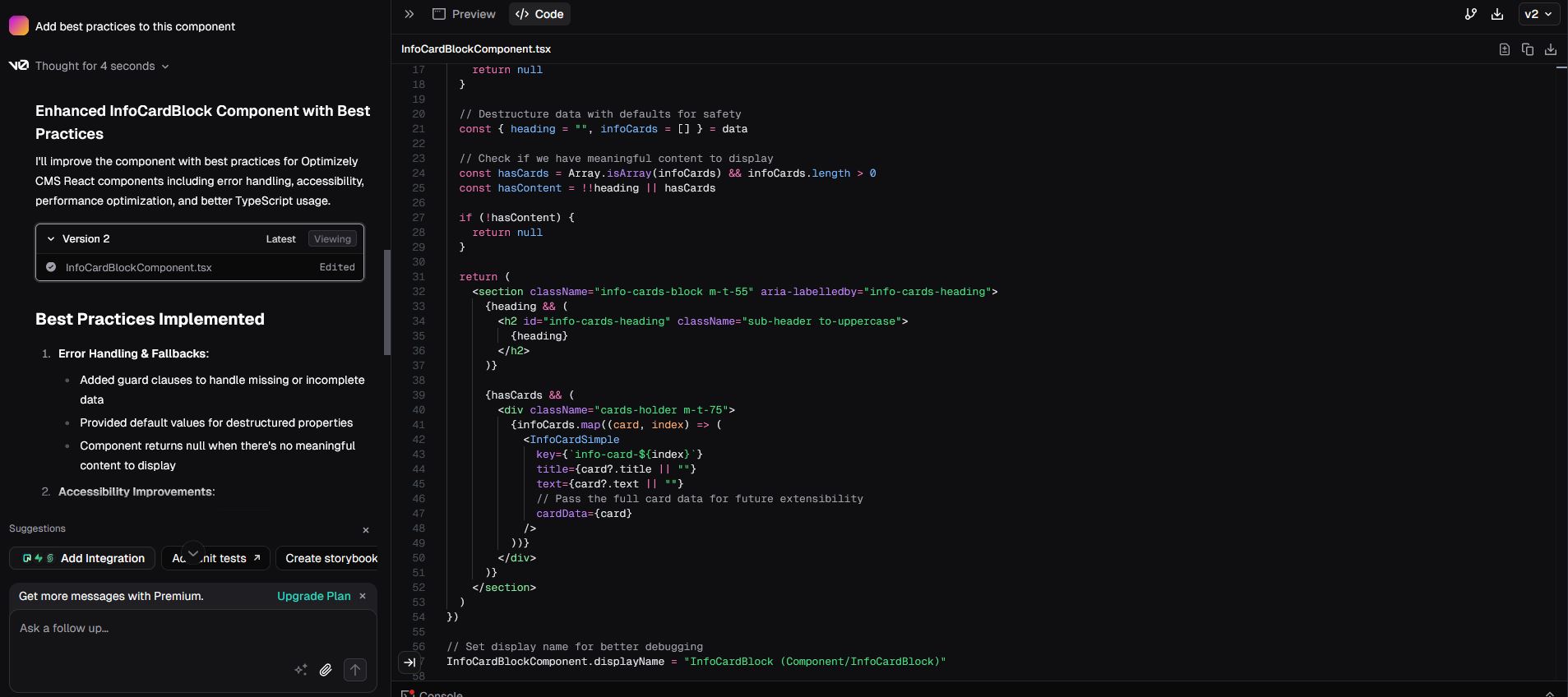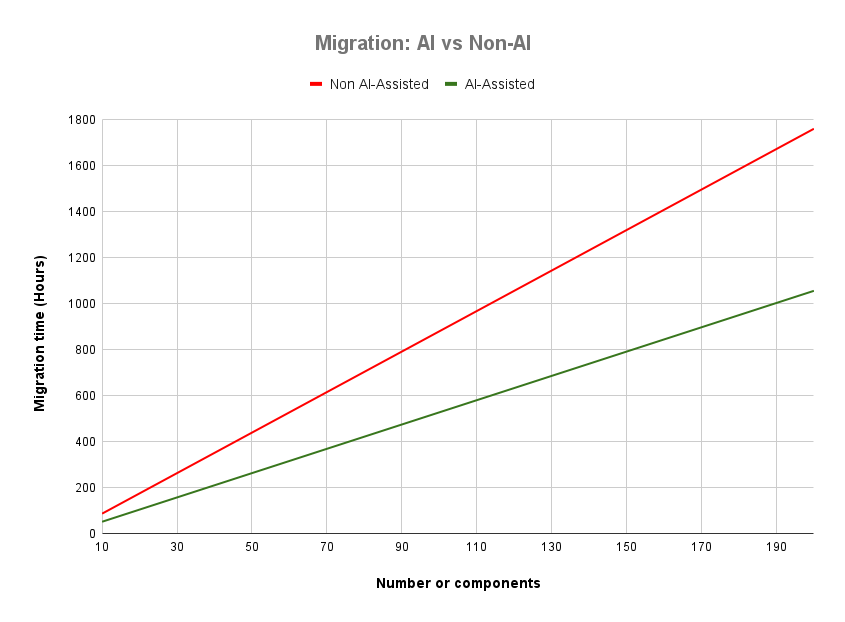Introduction
Migrating one CMS to another is a massive task, especially when switching between two headless architectures. Conversing headless frontend components can involve significant changes to rewrite logic, data mapping, and integration patterns. In the end every bit of help counts in making this process more efficient and faster.
In this article you’ll find out how AI-powered tool can assist in migrating frontend components to Headless Optimizely.
Why AI for migration
In a few words: speed and consistency.
You always want to reduce time for migration and you want to make sure all components are not written/migrated in different styles.
For migrations you'll want to rebuild presentation logic to align with the new framework, improve code with best practices and latest standards etc. AI tool can offload much of this rework by leveraging its AI capabilities to generate or refactor components based on prompts or previous examples. It helps by:
- Automating repetitive patterns
- Applying best practices to new components
- Enabling rapid iteration with a human-in-the-loop model
- Learning from your existing migrated files to improve consistency
So which AI tool should be used?
Vercel v0
AI tools are constantly emerging to help writing code faster, smarter, and more consistent. Fortunately for migration to Optimizely we have a perfect candidate to use - Vercel v0. It's a perfect match, because Vercel is partnered with Optimizely, which gives it much more credibility to use it in real life scenarios.
Vercel says that "Vercel v0 is a pair programmer that lets you describe your ideas in natural language and generates both the code and UI for your project". What does that mean for our case? In very short, it means that it can greatly accelerate migration and can give consistency across all components with the same results. It can be super valuable during large-scale frontend migrations.
Using examples for learning
One of the best benefits of v0 is its ability to learn from examples. After you've manually migrated a few components (more complex the better), you can use those files as reference points for generating components.
How? Simple:

1. You’ll have to include both old and new component files with descriptions of the changes, add next component files to migrate and in prompt write for example “migrate component X in the same way as in examples of component Y”. Of course you can phrase it however you want.
2. After you get the initial result, if it looks good enough then you can test it straight away by either copying code, or by using Preview. Please note to use Preview feature you'll need to include all required files, or even whole project.
3. Use the v0 prompt further to adjust generated files to your liking. For example you could add modern practices like hooks or performance optimizations. This is an important step for v0 to learn logic in migration of other components.
4. Vercel will also tell you which version it is displaying, so you don't need to worry about copy pasting and saving each version yourself.
Below you can see an example of version 2 with best practices added to the component. It improved code, readability and only took few seconds to generate:
That is not all. Although not always needed for migration, it's always nice to have some tests. One simple prompt of "Create unit tests for the component" will generate test file that is ready to use:
Manual work
No matter how powerful AI will be, not every component will be migrated perfectly, especially complex ones involving deeply nested logic, third-party integrations, or CMS-specific traits. It’s the same for v0, so manual work will still be required. However, the more components you fine-tune and give as examples, the more robust your result becomes, allowing you to reuse those improved files as guides for the rest.
This creates a compounding effect - every migrated and manually refined component becomes a seed that improves the speed and quality of subsequent generations.
Manual work is also the reason why you’ll still need experienced developers to do the work, or at least help and overview the whole migration process.
How much you can get
There is no definite answer on how much you can get with using AI like Vercel v0, because as always it depends. Depends on how many components are there to migrate, how many developers will need to work on migration, how experienced developers are or even what is the deadline of migration. There are simply too many factors to have one answer, but definitely everyone will agree that the bigger the migration, the more you can get.
Lets put to use some examples and calculations, based on simple high level plan:
- Time to learn AI tool - fortunately that's an easy part, as learning all basics and be able to start using the AI tool in a way which will be helpful can even take few hours, but lets round this to 8 hours (1 day).
- Component migrations (percentage) - we can assume that not everything will be handled through AI tool. Most of the basic components should be handled completely by AI. More complex components can also be handled, but with some manual work. Based on that we can assume at least 30-40% of increased speed of migration. More experienced teams with more familiarity of AI tool can increase that to even higher numbers, but for calculations lets assume 40% is safe number.
- Component migrations (time) - lets assume that only 30% of all components are complex and will take 2-3 days to migrate, so about 20 hours each. All other (70%) are simple components and shouldn't take more than 4 hours each to migrate.
- Developers - with AI tool we can assume that more experienced developer can either be needed only at start to migrate few components, or only to overview the work. We can't calculate it into time easily, but it's worth to note this.
- Tests - AI can generate unit tests for migrated components as displayed above. Additional effort of maybe 30 min per component vs hours by writing tests manually. For our calculation I'll leave this out as it's not always required to add tests with migration.
Chart below represents just one example of above numbers and already as expected it's clear that the more components needs to be migrated, the more time we can save by using AI:
Conclusion
Everyone who migrated anything will agree that migration is huge, complex and time-consuming work. Thankfully with modern AI tools like Vercel v0 the process can become much easier and faster.
Even if an AI tool won’t do all the work for you, if it helps at least a little, it’s most likely still worth it to use it for migration and to accelerate the whole process by making what once felt like a mountain of work much more manageable.
Contact us if you need a help with content migration between DXP platforms in your organization.


